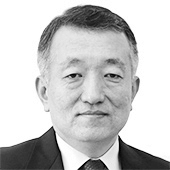The bare face of Korea in crisis

Koh Hyun-kohn
The author is the executive editor of the JoongAng Ilbo.
The primary medical facility in the capital, Seoul National University (SNU) Hospital, descended into mayhem after North Koreans stormed across the border in the wee hours of June 25, 1950. Within three days, the troops were closing in on the hospital gate. But medical staff could not abandon the injured. They remained at their side. North Korean soldiers barged into the hospital and fired mercilessly at the bedridden and medical caregivers. Around 900 were killed on the premises. Survivors were shot to death or taken hostage. A memorial monument stands in front of the hospital building to remember the massacre that took place on June 28, 1950.
Regardless of their reasons, it is deplorable that doctors deserted their places in the emergency, critical care and surgery rooms to protest the government’s plan to increase medical school enrollment quota. They too easily relinquished the duties their predecessors fought for with their lives. People are shocked and disappointed at their coldness. If they had endeavored to protect their patients by taking turns to attend to at least the inpatients in the critical and emergency units, their protest could have earned public sympathy. Bang Jae-seung, the interim head of the Medical Professors Association of Korea, last week admitted that without the people, there would be no need for doctors. But the apology came too late, and its sincerity did not reach the people. The breach of trust may remain as a lasting scar.
Noh Hwan-kyu, former chairman of the Korean Medical Association, called the government “foolish” for thinking it could prevail over doctors. It reflects a sense of self-importance and elitism embedded in his profession. He obviously has not learned that “humility is the mother of all virtues.”
The medical crisis exposed the conflict across different social classes and between the rich and poor. The schism runs deeper than the ideological, regional or generational gap. The rift has widened due to the breakdown of the middle class. In every private gathering, there are some who entirely side with the doctors. Pitying junior doctors, a CEO of a big company said trainee doctors on walkout should regard it as a sabbatical year with an unusually sharp tone, showing no sympathy for patients. It was later revealed that his daughter was a resident doctor at a general hospital.
The way the government deals with the ongoing medical crisis is also coarse and clumsy, with no strategy or publicity campaign to justify the enrollment quota hike. The issue of lifting the quota has been a bone of contention involving various conflicts of interests. The government should have had a specific and meticulous plan to persuade sundry parties involved. It should have been able to clearly explain how it came up with the figure of 2,000 for the hike, where and from whom the additional students can learn, how complicated insurance payments can work out and how the overbearing workload for trainee doctors can be solved, among other issues.
The government has invited such fierce backlash because it pushed ahead with the 2,000-enrollment hike while leaving out the essential details, being either too naïve or over-confident.

It released the plan to bolster the four primary medical divisions like pediatrics and emergency departments — which suffer from a chronic shortage of physicians — only five days before the announcement of the increase. It should have taken time to talk to doctors over the package instead of hurriedly arranging a debate after the walkout by trainee doctors. It did things in reverse.
It would have been better if the government had held a hearing on multiple options for the quota hike instead of dropping the announcement as if it had been a military operation. It hastily assigned universities allocations. The government seems to have been buoyed by a rising approval rating for its hard stance against doctors. It was nearsighted. The public can easily turn negative if the medical inconvenience worsens. After its rating started drooping, the government suddenly turned reconciliatory towards doctors.
President Yoon Suk Yeol in his New Year’s address vowed to push ahead with labor, education and pension reforms with “unwavering” drive. He said the same thing in his New Year’s speech last year, which was his campaign pledge in 2022. The president is already halfway into his five-year term, and is yet to implement his signature campaign promise. He suddenly went zealous about ideological principles and committed himself to win the World Expo 2030 for Busan as if the country’s future depended on it. He wasted too much of his valuable time trying to justify various controversies related to his wife and inner circle. The three-sector reforms hardly have any hope of seeing daylight if he cannot even solve the conundrum over the med school quota.
Both doctors and the government should be ashamed of themselves for unsettling the people. Yet no one is apologizing, and there is no one who can be relied on to referee the conflict. The people are once again on their own to find a cure for their illness. The country is in crisis.










with the Korea JoongAng Daily
To write comments, please log in to one of the accounts.
Standards Board Policy (0/250자)